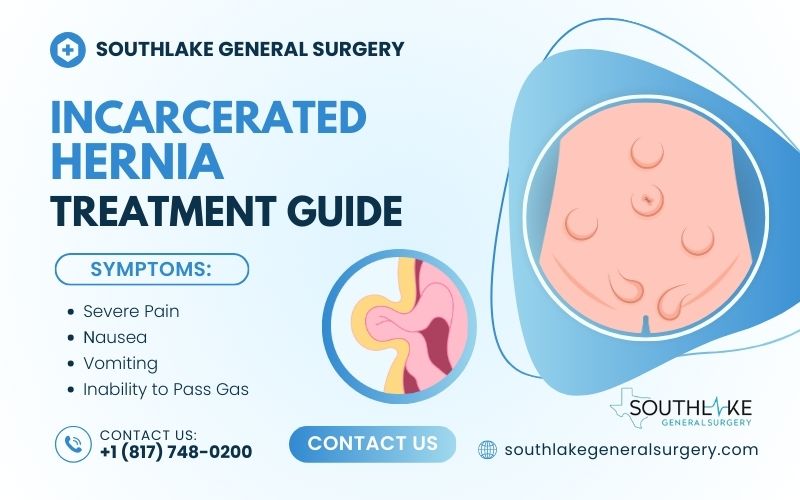Incarcerated hernia is a condition in which abdominal organs or tissues protrude through a weak spot in the abdominal wall and become trapped. It is a common surgical emergency that requires prompt medical attention.
An incarcerated hernia can occur in various areas of the abdomen, including the inguinal region, umbilical area, and femoral region. The most common type of incarcerated hernia is the inguinal hernia, which occurs in the groin area. Other types include umbilical hernia, femoral hernia, and incisional hernia.
The symptoms of incarcerated hernia can vary but often include a bulge or swelling in the affected area, abdominal pain or discomfort, and difficulty with bowel movements. If left untreated, incarcerated hernia can lead to serious complications such as bowel strangulation, testicular torsion, and testicular necrosis.
Diagnosing incarcerated hernia involves a physical examination by a healthcare professional and imaging tests such as CT scans. Treatment options for incarcerated hernia can be non-surgical, such as manual reduction, or surgical, such as laparoscopic surgery. Postoperative care and recovery are also crucial for a successful outcome.
In the following sections, we will delve into more detail about the definition and importance of incarcerated hernia, its causes, and risk factors, symptoms to watch out for, diagnostic approaches, treatment options, and tips for preventing hernia recurrence. We will also address frequently asked questions about incarcerated hernia.
Key Highlights
- Incarcerated hernia is a common surgical emergency that occurs when abdominal organs or tissues protrude through a weak spot in the abdominal wall.
- Symptoms of incarcerated hernia include a bulge in the groin area, abdominal pain, and difficulty with bowel movements.
- Diagnosis of incarcerated hernia is done through physical examination and imaging tests such as CT scans.
- Treatment for incarcerated hernia can be non-surgical, such as manual reduction, or surgical, such as laparoscopic surgery.
- Postoperative care and recovery for incarcerated hernia include pain management, wound care, and lifestyle modifications to prevent hernia recurrence.
- It is important to seek medical attention promptly for an incarcerated hernia to avoid serious complications.
Understanding Incarcerated Hernia
An incarcerated hernia occurs when part of the intestine or abdominal tissue becomes trapped in the abdominal wall, specifically in the abdominal cavity, leading to serious complications.
This condition, if left untreated, can progress to a strangulated hernia, cutting off blood supply and causing significant pain and life-threatening complications.
Understanding the importance of early recognition and medical intervention is crucial to prevent further complications and ensure prompt treatment.
Identifying the causes, symptoms, and risks associated with incarcerated hernias, specifically the contents of the hernia and the pressure in the abdominal cavity, is vital for timely diagnosis and appropriate management.
Causes and Risk Factors
Strain on the abdominal wall, heavy lifting, or persistent coughing are common causes of incarcerated hernias. Factors like age, male gender, and a family history of hernias increase the risk.
Conditions leading to increased abdominal pressure, such as constipation or obesity, can also contribute to hernia development.
Symptoms of Incarcerated Hernia
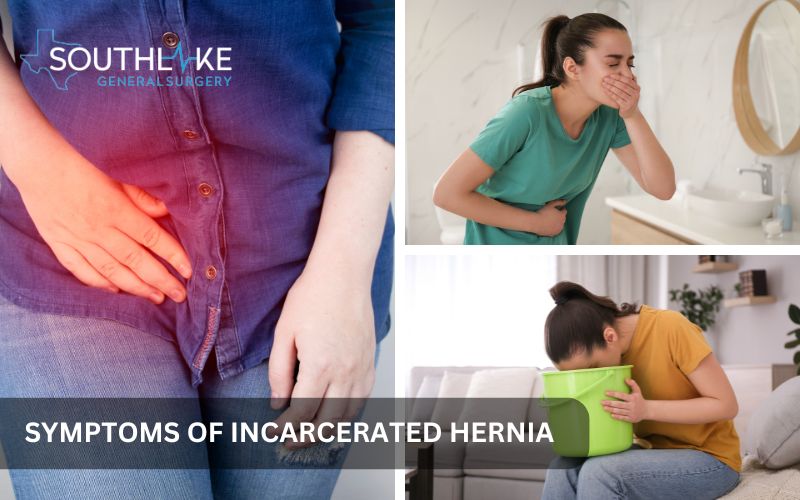
An incarcerated hernia may present symptoms such as:
- severe pain
- nausea
- vomiting
- the inability to pass gas or have a bowel movement
These symptoms can indicate a potentially serious complication where the hernia becomes trapped and requires immediate medical attention to prevent strangulation.
If you experience sudden, intense pain in the groin area on the right side accompanied by these symptoms, seek urgent medical care to avoid further complications. Prompt diagnosis and treatment are crucial in managing an incarcerated hernia.
Identifying Common Signs
One of the common signs of an incarcerated hernia is a visible bulge or lump in the affected area, often the abdomen or groin. This resulting bulge can be painful to the touch and can increase in size when standing or straining.
Other symptoms include persistent discomfort, nausea, and vomiting, indicating potential complications.
In some cases, the skin over the herniated area may appear red or inflamed due to the trapped tissues. Seeking immediate medical attention is crucial when experiencing these signs to prevent further complications.
When to Seek Medical Attention
If you experience persistent pain in the groin area, notice a visible hernia bulge, or have difficulty passing stools due to an incarcerated hernia, seek immediate medical attention. Other concerning signs include nausea, vomiting, and the inability to push the hernia back in.
These symptoms may indicate a potentially dangerous situation like a strangulated hernia, requiring urgent evaluation and treatment to prevent serious complications.
Delaying medical care for an incarcerated hernia can lead to bowel strangulation and impaired blood supply, necessitating quick intervention.
Diagnostic Approaches
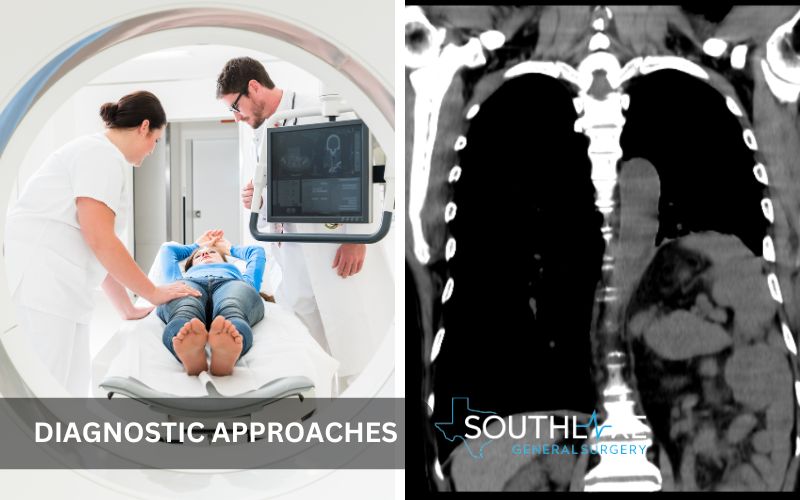
One of the primary methods for diagnosing an incarcerated hernia involves a comprehensive physical examination, focusing on the abdominal wall and groin area. This examination aims to identify any abnormal bulges or hernia protrusions.
In addition to physical assessments, imaging tests such as CT scans may be utilized to visualize the hernia and its contents more clearly.
Combining these diagnostic approaches allows healthcare providers to accurately determine the nature and severity of the hernia, guiding appropriate treatment decisions effectively.
Physical Examination
During the physical examination for an incarcerated hernia, the healthcare provider will carefully assess the affected area, typically the abdominal wall or groin region, for any signs of a protruding hernia bulge.
They may gently palpate the area to determine the size, tenderness, and consistency of the hernia.
Additionally, they will look for symptoms of bowel obstruction such as abdominal tenderness, distension, and possible signs of intestinal strangulation.
An accurate physical examination plays a crucial role in diagnosing an incarcerated hernia promptly and guiding further treatment.
Imaging Tests Explained
Imaging tests play a crucial role in diagnosing incarcerated hernias, including:
- CT scans
- Ultrasounds
- MRIs
- CT scans can reveal bowel strangulation or acute inflammation, guiding treatment decisions
- Ultrasounds are useful for identifying hernia contents and involved blood vessels
- MRIs offer a comprehensive view of abdominal organs, aiding in the differential diagnosis of hernias
These imaging modalities help healthcare providers accurately assess the severity of the condition.
Treatment Options by Dr. Valeria Simone
Dr. Valeria Simone offers tailored treatment options for incarcerated hernias, considering each patient’s unique condition. Non-surgical interventions may be recommended for less severe cases, focusing on lifestyle modifications and monitoring.
Surgical procedures, including laparoscopic surgery, are utilized for more complex hernias to ensure effective repair and prevent recurrence.
Dr. Simone excels at providing comprehensive care, from diagnosis to postoperative support, ensuring optimal recovery and reducing the risk of complications. Trust her expertise at Southlake General Surgery for personalized and effective treatment.
Non-Surgical Interventions
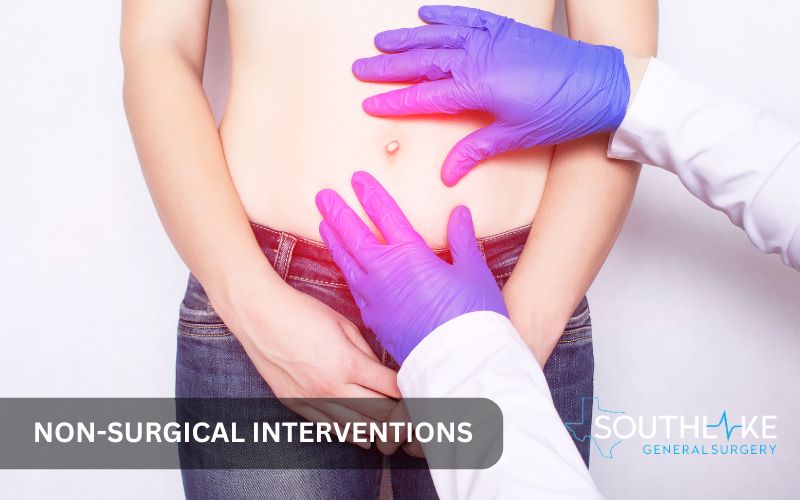
Some cases of incarcerated hernias can be managed through non-surgical interventions. Techniques such as manual reduction may be attempted under medical supervision to gently push the hernia back into place.
Patients should be closely monitored afterward to prevent complications. However, it’s crucial to understand that non-surgical approaches may not always be effective, and surgical intervention could be necessary in certain situations.
It’s essential to consult a healthcare professional for personalized guidance on the most appropriate treatment plan.
Surgical Procedures for Incarcerated Hernia
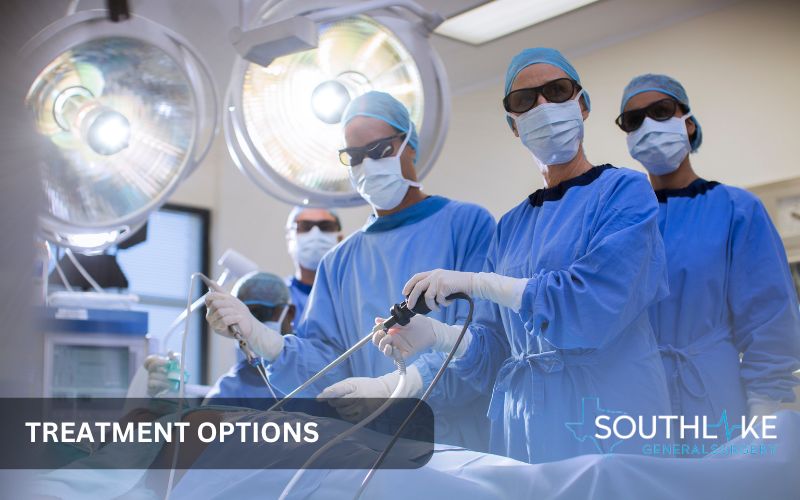
Laparoscopic surgery is often the preferred method for treating incarcerated hernias, allowing for minimal invasion and faster recovery.
During the procedure, the surgeon makes small incisions, inserts a camera, and uses specialized instruments to repair the incarcerated inguinal hernia, a technique known as laparoscopic inguinal hernia repair.
In cases of bowel strangulation, immediate surgery is crucial to prevent serious complications.
The surgical team carefully examines the hernia sac and its contents to determine the appropriate course of action, which may include removing any compromised bowel tissue and reinforcing the abdominal wall with synthetic mesh.
Successful outcomes largely depend on prompt intervention and skilled surgical techniques.
Preparing for Surgery at Southlake General Surgery
Before undergoing surgery at Southlake General Surgery, it’s crucial to follow preoperative instructions diligently.
This includes fasting as directed by your surgeon and disclosing your complete medical history. Prepare for potential bowel movements post-surgery and organize help for your recovery period.
Understand the risks and benefits of the procedure to make an informed decision. Southlake General Surgery will provide specific guidelines tailored to your case, ensuring a smooth surgical experience. Following these preparations will contribute to a successful outcome.
What to Expect
After undergoing surgery for an incarcerated hernia, patients can expect some discomfort and pain at the surgical site, which is manageable with medication.
It is common to experience swelling and bruising as the body heals. Patients should follow postoperative care instructions diligently to aid recovery and minimize complications.
Light activities are typically permitted, but heavy lifting should be avoided. Regular follow-up visits with the healthcare provider are crucial to monitor progress and ensure proper healing.
Preoperative Care Guidelines
Before hernia surgery, following specific preoperative care guidelines is crucial. These may include fasting for several hours before the procedure to ensure an empty stomach.
Additionally, informing the medical team about any medications or supplements being taken is essential.
It’s advised to arrange transportation to and from the medical center on the day of surgery. Following these guidelines can help ensure a smoother preoperative experience and contribute to a successful outcome.
Postoperative Care and Recovery
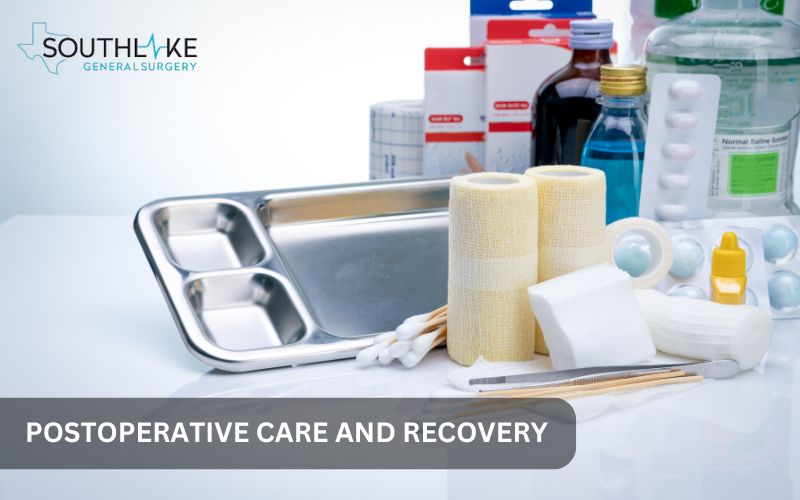
After undergoing incarcerated hernia surgery, diligent postoperative care is crucial. Dr. Valeria Simone emphasizes following specific instructions for a successful recovery.
Immediate care involves managing pain and incision site care to prevent infections. Long-term care includes gradually resuming regular activities while avoiding strenuous tasks.
Contact Southlake General Surgery promptly if any concerning symptoms arise during recovery. Adherence to postoperative guidelines ensures a smooth healing process and reduces the risk of complications, promoting a swift return to daily life.
Stay proactive and attentive during your postoperative phase for optimal recovery.
Immediate Post-Surgery Care
Following incarcerated hernia surgery, immediate post-surgery care is crucial. Patients should expect pain and soreness at the surgical site, which can be managed with prescribed pain medications.
- It is essential to follow the surgeon’s instructions regarding incision care to prevent infections, especially for patients with accompanying medical conditions.
- Light activities are recommended initially, gradually increasing as advised.
- Monitoring for signs of complications like fever, excessive bleeding, or worsening pain is vital.
- Keeping the surgical area clean and dry promotes proper healing.
- Adequate rest and hydration play key roles in the recovery process.
- Always consult your healthcare provider for any concerns.
Long-Term Recovery Tips
For long-term recovery after hernia surgery, it’s essential to follow postoperative care guidelines diligently, such as:
- Avoid heavy lifting to prevent straining the abdominal muscles
- Engage in gradually increasing physical activity under medical advice
- Maintain a balanced diet to support healing and overall well-being
- Attend all follow-up appointments as scheduled for ongoing monitoring of your recovery progress
- Adhere to lifestyle modifications recommended by your healthcare provider to reduce the risk of hernia recurrence
Preventing Hernia Recurrence
To prevent hernia recurrence, it’s vital to make lifestyle modifications. Avoid heavy lifting and engage in regular exercise to strengthen abdominal muscles. Follow postoperative care guidelines diligently and attend all follow-up visits for ongoing monitoring.
By maintaining a healthy weight and avoiding activities that strain the abdominal wall, the risk of recurrence can be significantly reduced.
Adhering to these recommendations can promote a successful recovery and lower the chances of hernia reoccurrence. Strive for proactive measures to safeguard against future complications.
Lifestyle Modifications
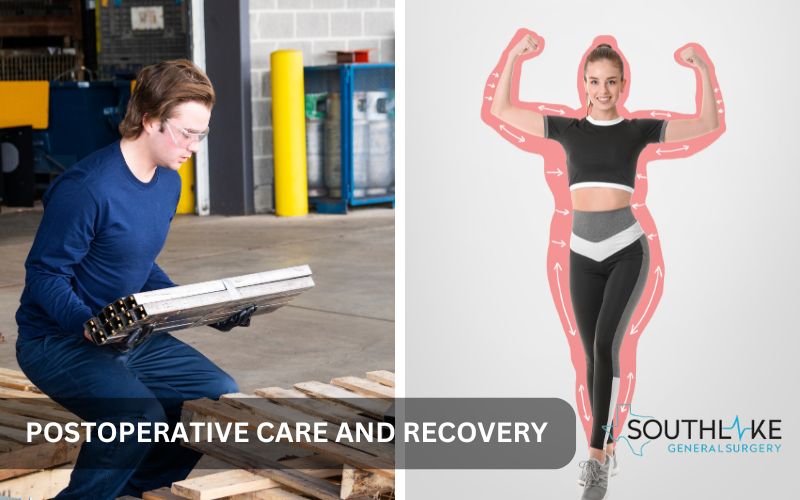
Adopt certain lifestyle modifications to reduce the risk of incarcerated hernia recurrence, such as:
- Maintain a healthy weight through a balanced diet and regular exercise to prevent excessive strain on the abdominal wall
- Avoid heavy lifting and use proper lifting techniques to protect against hernia development
- Quit smoking to avoid impairing the healing process post-surgery
These simple adjustments can significantly contribute to a successful recovery and lower the chances of hernia reappearance.
Follow-up Visits and Ongoing Monitoring
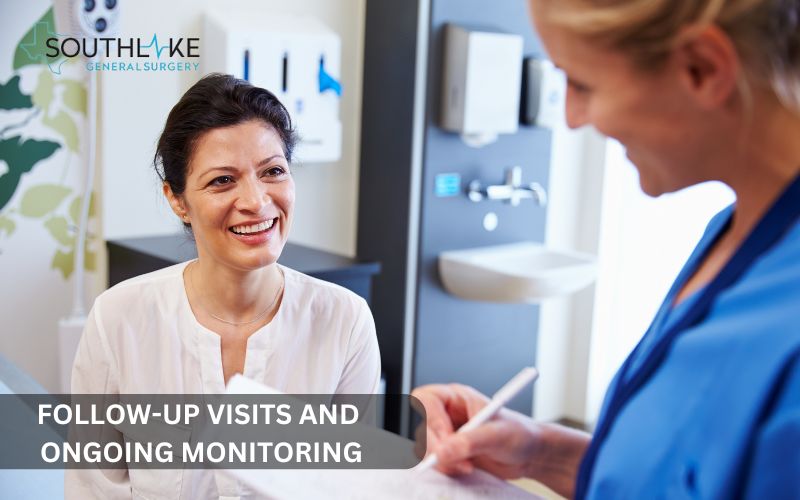
After treatment for an incarcerated hernia, follow-up visits, and ongoing monitoring are crucial. These appointments ensure the proper healing of the abdominal wall and check for any signs of hernia recurrence.
Regular consultations also allow the healthcare provider to assess the effectiveness of the chosen treatment and address any emerging issues promptly.
Monitoring may involve physical examinations, imaging tests, and discussions about lifestyle modifications to prevent future complications.
Continuous medical supervision post-surgery plays a vital role in the successful recovery and long-term well-being of the patient.
Outlook
While the outlook for incarcerated hernia treatment is generally favorable, prompt medical attention is crucial. With advancements in surgical techniques like laparoscopic surgery, outcomes have significantly improved.
However, delaying treatment can lead to serious complications such as bowel strangulation or necrosis, requiring immediate intervention.
By following postoperative care guidelines diligently and attending follow-up visits, patients can reduce the risk of hernia recurrence and ensure a smooth recovery process.
Persistence in adhering to medical advice and lifestyle modifications is key to long-term hernia management.
Make An Appointment
To book an appointment with Dr. Valeria Simone MD, at Southlake General Surgery in Texas, USA, please contact our healthcare expert today at +1 (817) 748-0200. Dr. Simone specializes in hernia treatments, including surgical procedures and non-surgical interventions.
Whether you are dealing with an inguinal or femoral hernia, Dr. Simone and her team are well-equipped to provide top-tier care.
Don’t hesitate to reach out for expert consultation and personalized treatment plans. Your journey to hernia recovery starts with a simple phone call. Make your appointment today!
Frequently Asked Questions
How do you know if a hernia is strangulated or incarcerated?
Symptoms like severe pain, nausea, vomiting, and a tender bulge that can’t be pushed back could indicate a strangulated or incarcerated hernia. These symptoms require immediate medical attention to prevent complications.
Can an incarcerated hernia lead to complications if left untreated?
Untreated incarcerated hernias can lead to severe complications like bowel obstruction or strangulation, which are medical emergencies requiring immediate intervention. Ignoring symptoms and delaying treatment can escalate the condition, posing health risks.
Are there any lifestyle changes that can help manage or prevent a recurrence of an incarcerated hernia?
To help manage or prevent a recurrence of an incarcerated hernia, it’s advisable to maintain a healthy weight, avoid heavy lifting, quit smoking (if applicable), and practice proper lifting techniques. Regular exercise, a high-fiber diet, and avoiding straining during bowel movements can also be beneficial.
Medically Reviewed By: Dr. Valeria Simone MD
Board-certified General Surgeon at Southlake General Surgery, Texas, USA.
Follow us on Facebook and YouTube.
References:
- Keeley JA, Kaji A, Kim DY, Putnam B, Neville A. Predictors of ischemic bowel in patients with incarcerated hernias. Hernia. 2019 Apr;23(2):277-280. doi: 10.1007/s10029-019-01884-1. Epub 2019 Jan 28. PMID: 30689076.
- Aguirre DA, Santosa AC, Casola G, Sirlin CB. Abdominal wall hernias: imaging features, complications, and diagnostic pitfalls at multi-detector row CT. Radiographics. 2005 Nov-Dec;25(6):1501-20. doi: 10.1148/rg.256055018. PMID: 16284131.
- Yang XF, Liu JL. Acute incarcerated external abdominal hernia. Ann Transl Med. 2014 Nov;2(11):110. doi: 10.3978/j.issn.2305-5839.2014.11.05. PMID: 25489584; PMCID: PMC4245506.

